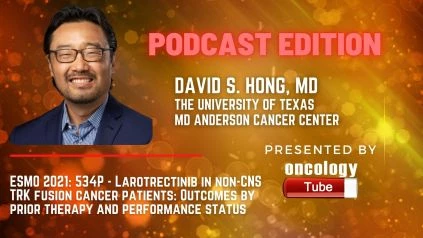David S. Hong, MD, the deputy chair of the Department of Investigational Cancer Therapeutics, Division of Cancer Medicine at The University of Texas MD Anderson Cancer Center speaks about ESMO 2021 – Abstract – 534P – Larotrectinib in non-CNS TRK fusion cancer patients: Outcomes by prior therapy and performance status – and – Long-term Efficacy and Safety of Larotrectinib in Patients with Advanced TRK Fusion-positive Thyroid Carcinoma.
Link to Abstract:
https://s3.eu-central-1.amazonaws.com/m-anage.com.storage.esmo/static/esmo2021_abstracts/534P.html.pdf
Background:
Larotrectinib is a first-in-class, highly selective, CNS-active tropomyosin receptor kinase (TRK) inhibitor approved in over 40 countries and by the European Medicines Agency for the treatment of TRK fusion cancer in adults and children. In a prior study, larotrectinib showed therapeutic improvement in 159 TRK fusion cancer patients with various levels of pre-treatment or performance status. We present updated information on larotrectinib outcomes by prior lines of systemic therapy and baseline performance status.
Methods:
Patients with non-CNS TRK fusion cancer were treated with larotrectinib in three clinical trials (NCT02122913, NCT02576431, and NCT02637687). Patients were divided into groups based on the number of preceding systemic lines.
therapy (0, 1, 2, or 3) or the comparable Lansky/Karnofsky performance level for children, or baseline Eastern Cooperative Oncology Group performance status (ECOG PS) (0, 1, 2 or 3). A post-hoc analysis was performed on the objective response rate (ORR; as determined by investigators using Response Evaluation Criteria in Solid Tumors v1.1), duration of response (DoR), progression-free survival (PFS), and overall survival (OS). The new data cut-off date was July 20, 2020.
Results:
A total of 218 patients were included in the study. The ORR was 75 percent (95 percent CI 68–81), the median DoR (mDoR) was 49.3 months (95 percent CI 27.3–not estimable [NE]), the median PFS (mPFS) was 35.4 months (95 percent CI 23.4–55.7), and the 36-month OS rate was 77 percent (95 percent CI 69–84) across all patients. The table shows the stratified efficacy results. Treatment-related Grade 3–4 adverse events occurred 19 percent, 24 percent, 14 percent, and 14 percent of the time in patients who had 0, 1, 2, or 3 prior lines of systemic medication, respectively.
Conclusions:
Although patients who were treatment-naive or had an ECOG PS of 0 had the best response rates, larotrectinib was beneficial to individuals with varying degrees of pre-treatment and baseline ECOG PS.
Clinical trial identification
NCT02122913, first posted April 25, 2014; NCT02637687, first posted 22 December 2015; NCT02576431: first posted 15
October 2015.
____________________________________________________________________________________________________________________________
David S. Hong, MD @DavidHongMD @MDAndersonNews #ATA21 #ThyroidCarcinoma #Cancer #Research Long-term Efficacy and Safety of Larotrectinib in Pts with Advanced TRK Fusion-positive Thyroid Carcinoma
David S. Hong, MD, the deputy chair of the Department of Investigational Cancer Therapeutics, Division of Cancer Medicine at The University of Texas MD Anderson Cancer Center speaks about the ATA 2021 Abstract – Long-term Efficacy and Safety of Larotrectinib in Pts with Advanced TRK Fusion-positive Thyroid Carcinoma.
Link to Abstract:
https://virtual.oxfordabstracts.com/#/event/public/2083/submission/169
Body of the Abstract:
Goal:
Larotrectinib is a first-in-class, highly selective, CNS-active tropomyosin receptor kinase (TRK) inhibitor that has a 75 percent objective response rate (ORR) in 206 evaluable adult and pediatric patients with non-primary CNS malignancies (Hong et al, ASCO 2021). In an extended cohort with longer follow-up, we report on the effectiveness and safety of larotrectinib in TRK fusion-positive thyroid cancer (TC).
Methodologies:
We combined data from three larotrectinib trials for individuals with locally advanced or metastatic TC with an NTRK gene fusion (NCT02576431, NCT02122913, and NCT02637687). ORR was evaluated by an investigator using RECIST v1.1. The deadline for data submission is July 20, 2020.
Findings:
There were 29 patients in all, with a median age of 60 [range 6–80] years. Papillary thyroid cancer (PTC) was found in 20 (69%) patients, follicular thyroid cancer (FTC) in 2 (7%), and anaplastic thyroid cancer (ATC) in 7 individuals (24 percent ). Patients had 0, 1, or 2 prior systemic therapy (with 1 unknown) in 12 (41%) cases, 7 (24%) cases, and 9 (31%) cases, respectively; 22 (76%) patients received prior radioactive iodine. ORR was 71 percent (95 percent confidence interval [CI] 51-87) among 28 evaluable patients, with 2 (7%) complete responses, 18 (64%) partial responses, 4 (14%) stable disease, 3 (11%) progressing disease, and 1 (4%) not identified. Patients with differentiated TC (DTC) had an ORR of 86 percent (95 percent CI 64-97), while those with ATC had an ORR of 29 percent (95 percent CI 4-71). The median time to respond was 1.9 months (range 1.6-3.7). Duration of response, progression-free survival, and overall survival were calculated by Kaplan-Meier to be 81 percent (95 percent CI 60-100), 69 percent (95 percent CI 49-90), and 76 percent (95 percent CI 58-93) at 24 months, respectively. The 24-month values for DTC were 84 percent (95 percent CI 62-100), 84 percent (95 percent CI 63-100), and 92 percent (95 percent CI 62-100). (95 percent CI 78-100). The 6-month readings for ATC were 50 percent (95 percent CI 0-100), 17 percent (95 percent CI 0-46), and 50 percent (95 percent CI 0-100). (95 percent CI 10-90). Two patients (7%) experienced Grade 3 larotrectinib-related adverse events (AEs), however, none of them stopped taking the drug because of them.
Outcomes:
Larotrectinib showed a high ORR and rapid and persistent disease control in patients with TRK fusion-positive DTC and a favorable safety profile. These findings support the use of NTRK gene fusion testing in individuals with advanced TC who require systemic therapy.

